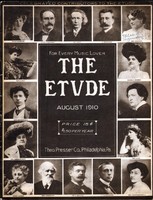BY JO-SHIPLEY WATSON.
Sarah was leaving the Conservatory and going to a little town out West. "One of those stupid places where you vegetate," she told her friends. She was leaving a good deal behind—the conservatory, the concerts, the galleries and hosts of congenial companions—the very things she loved best in the world, but Sarah was wonderfully brave-spirited and cheerful when the train slid out of the Dearborn station.
Willow Grove was a small town in every sense; small in size and small in outlook. There is a difference even between bad and worse, and Sarah knew that Willow Grove was worse. She "got started"— that was easy enough with no competition; there was not even the "twenty-five-cent teacher" to combat. Now the "getting started" was over the troubling thought was "How shall I keep up?" She said it again and again. How was she, indeed! Outside of the lessons it was a lifeless existence. "If I could teach in Chicago,' she said, "I would pace the galleries until I knew every picture; I'd go to the Symphonies until I knew every composer." Of course we know she could not have done it because she would have been too busy paying rent and making ends meet. In Willow Grove ends met and lapped over and time seemed a burden.
"To stand still is to retrograde." "It's easier to run down than to run up." These and a dozen other wise thoughts ran through her mind. She was entirely too conscious of the running down, so she made a plan and the following of it led to so many surprises that I believe every music student will be interested, for it is a true story of a real girl's ambition.
Activity makes time short and the winter in Willow Grove moved briskly because the plan was carried out with such vehement force. This was her plan:
First, to add one new piece or part of a piece, memorized, to her repertoire once in every two weeks. To play it Saturdays, at three o'clock, as though she were playing for her teacher.
Every Saturday fortnight, at three, the studio was put in order, the teacher's chair was placed, as it was at the Conservatory, at the right and a little back. Sarah came in, bowed, laid her music on the piano and began the lesson. The nerve tension was not relaxed one instant. Pieces, studies, technics were played straight through to the end of the forty minutes.
Here are some of the memorized pieces arranged in the form of a program. The unmemorized work was not counted as thoroughly learned and it was never recorded in Sarah's repertoire book.
Bach……. Prelude and Fugue in C minor.
Beethoven……. Sonata Op. 26, No. 2.
Chopin……. Nocturne F major.
Two preludes.
Etude C minor.
MacDowell……. Prelude E minor.
Witches' Dance.
Liszt……. Love Dream No. III.
Second, to try to become a thorough student of some great master. Beethoven was the master chosen and the subject was so staggeringly big that Sarah was on the point of dropping Beethoven for Haydn; but she held to her choice (that was fifteen years ago) and she is still studying and pondering over this great musical giant and, in all probability, she will be at it down to the end of time. To the Beethoven bibliography there is no end.
During the Winter she read a translation of Nohl's Beethoven, also Grove's valuable article in the "Dictionary of Music and Musicians." One of the best short articles she found in Chamber's Encyclopedia. Then there were Elterlein's "Beethoven Sonata" and Teetgen's "Beethoven Symphonies," and Grove's "Beethoven's Nine Symphonies," besides a great many magazine articles and the playing of reams and reams of music.
Sarah did not attempt to master any of it; she read the Sonatas, Minuets, Bagatelles and Variations as one reads a book, page after page and day after day. Some of the symphonies were looked over that season, but acquaintance with the chamber music came later.
Third, there were no galleries in Willow Grove and Sarah had found so much inspiration in paintings that the lack of them seemed more of a loss than the orchestral concerts. There seemed to be no substitute, but Sarah found one, and in place of pacing the galleries she walked every evening to College Hill for the sunsets. It was a refreshing walk after the day's work and there was always a superb view in fair weather. The sun set under all sorts of conditions that winter, sometimes behind broad smudges of gray, sometimes behind sheets of rain and sometimes it set in gold and purple haze—every one different and every one an inspiration.
Fourth, through this Sarah was finally lifted out of Willow Grove. It began in a correspondence with an Eastern music school and in diligent preparation for its entrance examination. Letters—not stereotyped business ones, but letters with real feeling—were exchanged. Sarah opened her heart and the dream that seemed so big at first became in time a reality. The entrance examination was taken, and, thanks to the concentration cultivated at the imaginary lessons at Willow Grove, Sarah passed with flying colors.



